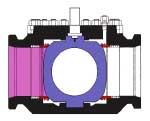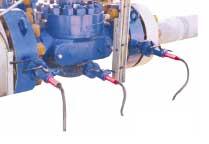
 | |
| Save Article Instructions | Close |
|
| |
| New tool tests shutdown valves on offshore platforms | |
|
Stan Hale | |
|
Availability, production output, and operation and maintenance costs are important offshore platform metrics that directly affect the bottom line. Required periodic testing of critical shutdown valves (SDVs) degrades availability, interrupts production, and increases maintenance cost. The test frequency for critical SDVs varies from monthly to annually, depending on the country and regulatory requirements. | |
|
The most common valve type used in offshore SDV applications is a 1/4-turn trunnion mounted ball valve. | |
 Closing a ball valve isolates the product on the upstream side by the ball blocking the inlet orifice. The seals, or seat, between the valve body and ball prevent leakage into the ball valve cavity. The other side of the ball and another seat block the downstream piping. Both seats must leak before product can pass completely by the valve. | |
|
SDV test procedures often require closing the main valve to assess the integrity of the valve seats. When an SDV is closed, the cavity fills with product and pressurizes. The upstream seat can be evaluated by venting the cavity and monitoring for an increase due to seat leakage. The cavity can also be pressurized with inert gas and monitored to evaluate the integrity of both seats. | |
|
Another test method used to evaluate SDV seat leakage is to close the valve and listen for indications of leakage past the seats with acoustic or ultrasonic sensors. This method requires that both seats leak, thereby generating a high frequency noise as pressurized product escapes to the lower pressure area downstream of the valve. Using information from the sound generated by the leakage and the magnitude of the upstream pressure, the relative size of the leak can be calculated. | |
|
Closing a ball valve isolates the product on the upstream side by the ball blocking the inlet orifice. The seals, or seat, between the valve body and ball prevent leakage into the ball valve cavity. | |
|
The drawback is all of the methods discussed require the valve to be closed for testing. When SDVs are closed, production stops. | |
|
Following the Piper Alpha accident, the Norwegian Petroleum Directorate increased pressure on oil companies operating in the North Sea to periodically test the ability of critical SDVs to perform as required during an emergency. Statoil and Norsk Hydro struggled with the impact of SDV testing requirements on production output and the increased O&M cost due to the testing process. Statoil, Norsk Hydro, and Crane Valve Services collaborated to develop an automatic online condition monitoring system for SDVs. ValveWatch systems, the result of that collaboration, are installed in Norway at the Kollsness onshore receiving station and offshore on the Gulfaks, Åsgard, Huldra, Oseberg East, Oseberg S, Kvitebjørn, Sleipner, and Grane platforms. | |
|
ValveWatch employs dynamic pressure sensors and strain gages to develop a complete picture of valve and actuator condition. Three piezoelectric dynamic pressure transducers monitor the upstream, downstream, and cavity pressures for fluctuations due to noise or vibrations in the flow stream. The cavity sensor can be installed on existing cavity vent outlets. The upstream and downstream sensors can be installed on the valve below or at instrument taps upstream and downstream of the valve. | |
|
Unlike typical pressure transducers, Valve-Watch dynamic pressure sensors provide a rapid output response due to minor changes or fluctuations in pressure. This constantly changing pressure signal is analyzed using time and frequency domain analysis methods to characterize noise patterns in the flow stream due to system dynamics and, at times, rotating equipment such as pumps and compressors in the flow line. The noise patterns in the flow stream are compared to the patterns detected by the cavity sensor to assess sealing integrity. The seat leakage tests are performed automatically while the valve is in service and in the open position. | |
 | |
|
A specially designed strain gage is mounted to the yoke or on the connection between the valve body and actuator in order to assess changes in the torque required to operate the valve. The torque data is recorded automatically any time the valve is operated for any reason, including for partial stroke testing. Partial stroke testing is often employed to detect indications of a change in actuator performance. This test approach is good for verifying the ability of the actuator to change position but does not provide information useful in evaluating potential valve seat leakage. Since the torque and pressure sensors are always on line, it may not be necessary to schedule additional partial stroke tests for valves that have been recently operated and have data recorded. A fifth input channel is available for each valve to enable monitoring of the control circuit or ESD solenoid operation. | |
|
The ValveWatch sensors are continuously online, and data can be acquired as needed to monitor the seats for potential leakage at any time. For example, the system can be programmed to perform a test in accordance with the current testing schedule whether monthly or annually. The test can also be scheduled once every hour for no additional cost. The valve remains in the full open position during the test. The process is automated and does not require user intervention until the potential for leakage is detected. In that case, the system alarm is activated and requires the user to acknow-ledge the alarm. Once the potential for leakage is detected, additional testing and analysis can be performed, or one of the manual leak testing methods discussed above can be employed to quantify the magnitude of the actual leakage. | |
|
The ValveWatch system is connected to the customer's computer network, and test results are transmitted back to shore for evaluation. For the systems in Norway, data is transmitted back to the Bjorge Solberg & Anderson data analysis center in Bergen, where the status of platform SDVs can be monitored around the clock. | |
|
Though ValveWatch is a relatively new product and the economic benefits
are not fully understood, Norsk Hydro has concluded that the leakage data
is consistent with the manual nitrogen test used to detect SDV leakage
during shutdowns. In the final analysis, it was also concluded that SDVs
could be tested using ValveWatch more frequently than required by
regulation at a much lower cost and without interrupting production.
| |
| Offshore November 01, 2003 volume 63, issue 11 Author(s) : Stan Hale | |
|
| |
| To access this article, go
to: http://www.offshore-mag.com/articles/article_display.cfm?ARTICLE_ID=192043&p=9 | |
|
Copyright © 2007: PennWell Corporation, Tulsa, OK; All Rights Reserved. | |